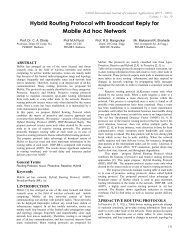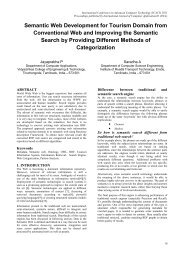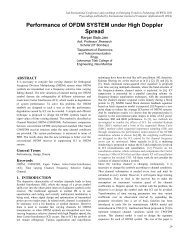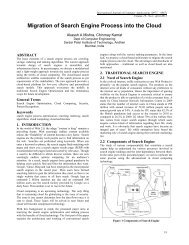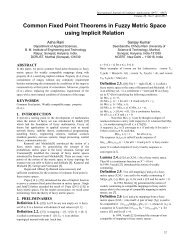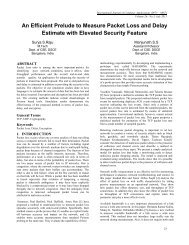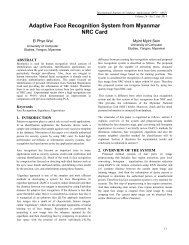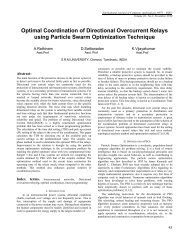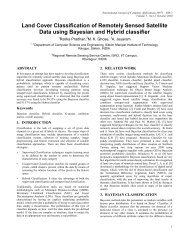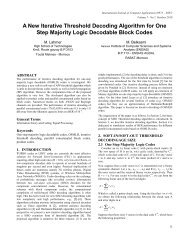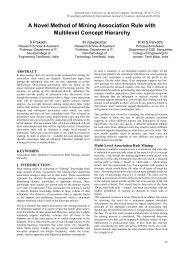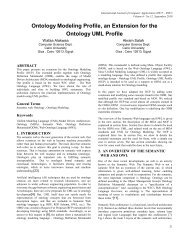Download - International Journal of Computer Applications - IJCA
Download - International Journal of Computer Applications - IJCA
Download - International Journal of Computer Applications - IJCA
Create successful ePaper yourself
Turn your PDF publications into a flip-book with our unique Google optimized e-Paper software.
Analysis and Generation <strong>of</strong> Bengali Case Structure<br />
Constructs for Universal Networking Language<br />
Md. Nawab Yousuf Ali<br />
Department <strong>of</strong> CSE<br />
East West University<br />
Dhaka, Bangldesh<br />
Mohammad Zakir Hossain Sarker<br />
USAID | DELIVER PROJECT<br />
House NE(O) 6, Road 92<br />
Gulshan-2, Dhaka, Bangladesh<br />
Jugal Krishna Das<br />
Department <strong>of</strong> CSE<br />
Jahangirnagar University<br />
Dhaka, Bangldesh<br />
ABSTRACT<br />
The Universal Networking Language (UNL) deals with the<br />
communication across nations <strong>of</strong> different languages and involves<br />
with many different related discipline such as linguistics,<br />
epistemology, computer science etc. It helps to overcome the<br />
language barrier among people <strong>of</strong> different nations to solve<br />
problems emerging from current globalization trends and<br />
geopolitical interdependence. Case structure analysis forms the<br />
foundation for any natural language processing task. In this paper<br />
we propose the computational analysis <strong>of</strong> the Bangla case<br />
structure and conversion <strong>of</strong> Bangla sentence to UNL expression.<br />
We also provide the implementation <strong>of</strong> our analysis taking one <strong>of</strong><br />
the cases as an example.<br />
Keywords<br />
Universal Networking Language (UNL), Bangla grammar, Bangla<br />
Word Dictionary, Inflexion, Verbal Inflexion, Bangla Case,<br />
Analysis Rule, Enconverter (EnCo)<br />
1. INTRODUCTION<br />
The Universal Networking Language (UNL), which is a formal<br />
language for symbolizing the sense <strong>of</strong> natural language sentences,<br />
is a specification for the exchange <strong>of</strong> information. Currently, the<br />
UNL includes 16 languages [1], which are the six <strong>of</strong>ficial<br />
languages <strong>of</strong> the United Nations (Arabic, Chinese, English,<br />
French, Russian and Spanish), in addition to the ten other widely<br />
spoken languages (German, Hindi, Italian, Indonesian, Japanese,<br />
Latvian, Mongol, Portuguese, Swahili and Thai). In the last few<br />
years, machine translation techniques have been applied to web<br />
environments. The growing amount <strong>of</strong> available multilingual<br />
information on the Internet and the Internet users has led to a<br />
justifiable interest on this area. Hundreds <strong>of</strong> millions <strong>of</strong> people <strong>of</strong><br />
almost all levels <strong>of</strong> education, attitudes and different jobs all over<br />
the world use the Internet for different purposes [2], where<br />
English is the main language <strong>of</strong> the Internet. But English is not<br />
understandable for most <strong>of</strong> the people. Interlingua translation<br />
programs are needed to develop. The main goal <strong>of</strong> the UNL<br />
system, which allows users to visualize websites in their native<br />
languages, is to provide a common representation for accessing<br />
Internet <strong>of</strong> multilingual websites by the majority <strong>of</strong> the people<br />
over the world. For this common representation, lexical<br />
knowledge is a critical issue in natural language processing<br />
systems, where the development <strong>of</strong> large-scale lexica with<br />
specific formats capable <strong>of</strong> being used by distinguished<br />
applications, in particular to multilingual systems, has been given<br />
special focus. Our goal is to include Bangla in this system with<br />
less effort.<br />
So far very little effort has been made to convert Bangla language<br />
to UNL expressions. We have been working on this topic from the<br />
last 3 years. To convert Bangla sentences into UNL expression we<br />
needed to go through the Bangla grammar and UNL very<br />
rigorously. Simultaneously we have communicated with the UNL<br />
center <strong>of</strong> the UNDL Foundation. They have made two agreements<br />
with us: i) Agreement for entering UNLs and ii) UDS agreement,<br />
and provided us user name and password to access their resources<br />
and utilities. Then we have started converting Bangla sentences<br />
into UNL expression successfully. Although we have already<br />
work on Bangla Simple and Compound sentences, but for better<br />
understanding <strong>of</strong> the most <strong>of</strong> the readers <strong>of</strong> this paper we have<br />
taken a simple affirmative Bangla sentence “আিম ভাত খাi” (Ami<br />
Vat Khai) means “I eat rice” and shown how it can be converted<br />
into UNL expression.<br />
The organization <strong>of</strong> this paper is as follow: In Section 2 we<br />
describe the Research Methodology/Literature Review, Section 3<br />
has the short description about UNL, Section 4 describes our<br />
work. Here we discuss about the dictionary entries and rules,<br />
which we have designed and developed to convert for each<br />
Bangla cases, section 5 explains how the rules, developed by us,<br />
will be applied taking a sentence as an example, section 6 shows<br />
the result <strong>of</strong> our work. In this section we have taken one <strong>of</strong> the<br />
cases as an example although we have worked on all the cases.<br />
Finally, Section 7 draws conclusions with some remarks on future<br />
works.<br />
2. LITERATURE REVIEW<br />
For converting Bangla sentence to UNL expressions firstly, we<br />
have gone through Universal Networking Language (UNL) [3, 4,<br />
5, 6] where we have learnt about UNL expression, Relations,<br />
Attributes, Universal Words, UNL Knowledge Base, Knowledge<br />
Representation in UNL, Logical Expression in UNL, UNL<br />
systems and specifications <strong>of</strong> Enconverter. All these are key<br />
factors for preparing Bangla word dictionary, enconversion and<br />
deconversion rules in order to convert a natural language sentence<br />
(here Bangla sentence) into UNL expressions. Secondly, we have<br />
rigorously gone through the Bangla grammar [7, 8, 9], Verb and<br />
roots (Vowel ended and Consonant Ended) [7, 8, 10],<br />
Morphological Analysis [10, 11, 12], Primary suffixes [7, 8, 12],<br />
Cases and their inflexions [8, 13], construction <strong>of</strong> Bangla sentence<br />
[9] based on semantic structure. Using above references we extort<br />
ideas about Bangla grammar for morphological and semantic<br />
34
analysis in order to prepare Bangla word dictionary (for root, root<br />
word suffix etc), morphological rules and enconversion rules in<br />
the format <strong>of</strong> UNL provided by the UNL center <strong>of</strong> the UNDL<br />
Foundation.<br />
3. UNL SYSTEM – IN A NUTSHELL<br />
Although, there is an immense proliferation <strong>of</strong> information<br />
through Internet, it is not accessible to vast multitude <strong>of</strong> people<br />
across nations as most <strong>of</strong> the resources are in English. To<br />
overcome this problem, United Nations launched Universal<br />
Networking Language project [10] in 1996. The result <strong>of</strong> the<br />
project is universal networking language (UNL), a language<br />
neutral specification, and a universal parser specification [11].<br />
The goal is to eliminate the massive task <strong>of</strong> translation between<br />
two languages and reduce language to language translation to a<br />
one time conversion to UNL.<br />
The UNL [12] has been introduced as a digital meta language for<br />
describing, summarizing, refining, storing and disseminating<br />
information in a machine independent and human language<br />
neutral form. This meta-language focuses to express meanings in<br />
standardized way. We think that a comprehensive description <strong>of</strong><br />
UNL specification is necessary though it is available in UNL<br />
website. The meaning <strong>of</strong> native language sentence is expressed in<br />
UNL system as a hypergraph composed <strong>of</strong> nodes connected by<br />
semantic relations. Nodes or Universal Words (UWs) are words<br />
loaned from English and disambiguated by their positioning in a<br />
knowledge base (KB) [10] <strong>of</strong> conceptual hierarchies. Function<br />
words, such as determiners and auxiliaries are represented as<br />
attributes to UWs or nodes to provide additional information. The<br />
core structure <strong>of</strong> UNL is based on the following elements [4]:<br />
1. Universal Words<br />
2. Attribute Labels<br />
3. Relation Labels<br />
4. UNL Expression<br />
5. Hypergraph<br />
6. Knowledge Base<br />
4. PROPOSED UNL STRUCTURE OF<br />
BANGLA CASE<br />
As in the traditional understanding case (in Bangla Kaarok) in<br />
Bangla denotes the relationship <strong>of</strong> the nominal with the main verb<br />
<strong>of</strong> the clause. The cases are broadly classified into 6 categories<br />
[7], each having a finer categorization into sub-types. The<br />
traditional case with their inflexions is shown in table 1.<br />
Table I. Bangla Cases and their inflexions<br />
Classical Case vs. Inflexions (Case maker)<br />
Bangla Kaarok Singular Plural<br />
Nominative 0 (null), e (e), য় রা (ra), eরা<br />
case(Kartri Kaarok) (oy), েত (te) (era)<br />
Accusative case 0 (null), েক (ke), িদগেক (digoke)<br />
(Karma Kaarok) ের (re), eের (ere)<br />
Instrumental case dারা (dara), িদয়া েদর dারা (der<br />
(Karan Kaarok) (dia), কতৃক dara), িদেগর<br />
Dative<br />
(Sampradaan<br />
Kaarok)<br />
case<br />
Ablative case<br />
(Apaadaan Kaarok)<br />
Genitive case<br />
(Sambandha pad)<br />
Case <strong>of</strong> time-place<br />
(Adhikaran Kaarak)<br />
(kortik) dারা (diger<br />
dara)<br />
0(null), েক(ke), িদগেক (digoke)<br />
ের(re), eের(ere),<br />
e(e), য়(oy),<br />
েত(et)<br />
হiেত (hoite), েদর হiেত (der<br />
েথেক (theke) hoite), িদেগর<br />
হiেত (diger<br />
hoite)<br />
র (r), eর (er) েদর (der),<br />
িদেগর (diger)<br />
e (e), য় (oy), সকেল (sokole),<br />
েত(te)<br />
েদর মেধ (der<br />
modde)<br />
In this paper, an exhaustive realization <strong>of</strong> the case system with a<br />
view to analyze Bangla into UNL has been carried out.<br />
4.1 Nominative case (Kartri Kaarok)<br />
This case is the form <strong>of</strong> a noun or pronoun used in the subject or<br />
predicate nominative. It denotes the agent <strong>of</strong> the action stated by<br />
the verb. For example, “কিরম পিড়েতেছ”, pronounce as Karim<br />
Poritechhe means “Karim is reading”. Here subject Karim<br />
initiates an action. So, agent (agt) relation is made between<br />
subject “Karim” and verb “read”.<br />
The following dictionary entries are needed for conversion the<br />
sentence [14]<br />
[কিরম] {} “karim (icl>name, i<strong>of</strong>>person,com>male)(N)<br />
[পR] {} “read (icl>see>do,agt>person,obj>information)<br />
(ROOT,CEND,^ALT)<br />
[iেতেছ] {} “”(VI, CEND, CEG1,PRS,PRG, 3P)<br />
where, N denotes noun, ROOT for verb root, CEND for<br />
Consonant Ended Root, ^ALT for not alternative, VI is attribute<br />
for verbal inflexion, CEG1 for Consonant Ended Group 1, PRS<br />
for present tense, PRG for progress means continuous tense and<br />
3P for third person.<br />
To convert this sentence into UNL expression morphological<br />
analysis is made between “পR” (por) and “iেতেছ” (itechhe) and<br />
semantic analysis is made between “কিরম” (karim) and<br />
“পিড়েতেছ” (poritechhe)<br />
• Rule <strong>of</strong> morphological analysis:<br />
After applying some right shift rules when verb root “পR”(por)<br />
comes in the LAW and verbal inflexion “iেতেছ”(itechhe) comes<br />
in the RAW then following rule is applied to perform<br />
morphological analysis discussed in 3.3.1.1<br />
+{ROOT,CEND,^ALT,^VERB:+VERB,-<br />
ROOT,+@::}{VI,CEND:::}P10;<br />
• Rule <strong>of</strong> semantic analysis:<br />
After morphological analysis when noun “কিরম” (karim) appears<br />
in the LAW and verb “পিড়েতেছ” (poritechhe) appears in the RAW<br />
the following agent (agt) relation is made between “কিরম” (karim)<br />
and “পিড়েতেছ” (poritechhe) to complete the semantic analysis.<br />
>{N,SUBJ::agt:}{VERB,#AGT:+&@present,+&@progress::}P1;<br />
35
where, NOM denotes the attributes for nouns or pronouns<br />
UNL Expression:<br />
{unl}<br />
agt(read(icl>see>do,agt>person,obj>information).@entry.@prese<br />
nt.@progress,karim(icl>name,i<strong>of</strong>>person,com>male))<br />
{/unl}<br />
4.2 Accusative case (Karma Kaarok)<br />
Accusative case is a noun or pronoun or thing on which the<br />
subject executes the verb. For example: “আিম ভাত খাi।”<br />
pronounce as “Aami vat khai” means “I eat rice.”<br />
The following dictionary entries are needed for the sentence.<br />
[আিম]{} "i(icl>person)"(PRON,HPRON,1P,SG,SUBJ)<br />
[ভাত]{} "rice(icl>food)"(N)<br />
[খা]{}"eat(icl>consume>do,agt>living_thing,obj>concrete_thing)<br />
” (ROOT,VEND,#AGT,#OBJ,VEG1)<br />
[i]{}"" (VI,VEND,1P,PRS)<br />
where, PRON denotes pronoun, HPRON for human pronoun, 1P<br />
for first person, SG for singular number and SUBJ for subject <strong>of</strong><br />
the sentence.<br />
To convert this sentence into UNL expressions a morphological<br />
analysis and two semantic analyses to be held [15].<br />
• Rule for morphological analysis:<br />
Morphological analysis between ‘খা’ (kha) and ‘i’ (e) to be held<br />
using the following rule detailed in section 4.1<br />
+{ROOT,VEND,^ALT,^VERB:+VERB,-ROOT,+@::}{VI,<br />
VEND:::}P10;<br />
• Rules for semantic analyses:<br />
For the above sentence two semantic relations are made. One<br />
semantic relation is agent (agt) relation to be held between “আিম”<br />
(aami) and “খাi” (khai) using the following rule detailed in<br />
section 4.1<br />
>{PRON,HPRON,SUBJ::agt:}{VERB,#AGT:::}P10;<br />
And another relation is between “ভাত” (rice) and “খাi” (eat)<br />
Here, rice is an object and relation between rice and eat is the<br />
accusative case.<br />
UNL rule for accusative case to perform semantic analysis is<br />
(detailed in 3.3.2.2):<br />
>{N::obj:}{VERB,#OBJ:+&@present.&@entry::}P10;<br />
UNL expression:<br />
{unl}<br />
agt(eat(icl>consume>do,agt>living_thing,obj>concrete_thing).@<br />
entry.@present,i(icl>person))<br />
obj(eat(icl>consume>do,agt>living_thing,obj>concrete_thing).@<br />
entry.@present,rice(icl>grain>thing))<br />
{/unl}<br />
4.3 Instrumental case (Karan Kaarok)<br />
Instrumental case is the thing, tool or method by which the subject<br />
<strong>of</strong> the sentence executes the specified action.<br />
For example:<br />
“েস কলম িদেয় eকিট েনাট িলেখিছল।” pronounce as Se kolom die<br />
ekti note likhechhilo, means “He wrote a note with a pen.”<br />
The following dictionary entries are needed for converting the<br />
sentence into UNL expression.<br />
[েস] {} “he(icl>person)”( PRON,HPRON,1P, SUBJ, MALE)<br />
[কলম] {} “pen(icl>writing_implement>thing”(N)<br />
[িদেয়] {} “” (INF, INF2ND, PRON)<br />
[েনাট] {} “note(icl>personal_letter)>thing)”(N )<br />
[িল] {}“write(icl>do, agt>person, obj>abstract_thing plc>thing,<br />
ins>functional_thing)” (ROOT, CEND)<br />
[eিছল]{} “” (VI, CER, 3P, PST)<br />
where, MALE denotes male, INF is the attribute for inflexion,<br />
INF2ND for second types <strong>of</strong> inflexion and PST for past tense.<br />
In this sentence two morphological and three semantic analyses<br />
are taken place:<br />
• Rules for Morphological Analyses:<br />
The following rules are applied to complete morphological<br />
analyses between “কলম” (kolom) & “িদেয়” (die) and between<br />
“িল” (likh) & “eিছল” (echhilo) detailed in section 3.3.1.1<br />
+{N:@::} {INF, INS:::}<br />
+{ROOT,CEND,^ALT,^VERB:+VERB,-ROOT,+@::}{VI,<br />
CEND : &@past::}<br />
• Rules for semantic analyses:<br />
First semantic relation is object (obj) relation which is made<br />
between “েনাট” (note) “িলেখিছল” (likhechhilo) using the<br />
following rule discussed in section 3.3.2.2<br />
>{N::obj:}{VERB,#OBJ:+&@past::}P10;<br />
Second semantic relation is made between “কলম” (pen) which is<br />
instrument and “িলেখিছল” (wrote) is instrumental case.<br />
Rule for instrumental case to perform semantic analysis is:<br />
(detailed in section 3.3.2.2)<br />
>{PRON, HPRON, INS::ins:}{VERB:+&@past::}<br />
Third semantic relation is object (obj) relation to be held between<br />
“েস” (he) and “িলেখিছল” (wrote) using the following rule detailed<br />
in section 4.1<br />
>{PRON,HPRON,SUBJ::agt:)}{VERB:+&@past.&@entry::}<br />
UNL expression:<br />
{unl}<br />
agt(write(icl>do,agt>person,obj>abstract_thing,plc>thing,ins>fun<br />
ctional_thing).@entry.@past,he(icl>person))<br />
obj(write(icl>do,agt>person,obj>abstract_thing,plc>thing,ins>fun<br />
ctional_thing).@entry.@past,note(icl>personal_letter>thing).@in<br />
def)<br />
ins(write(icl>do,agt>person,obj>abstract_thing,plc>thing,ins>fun<br />
ctional_thing).@entry.@past,pen(icl>writing_implement>thing).<br />
@indef)<br />
{/unl}<br />
36
4.4 Dative case (Sampradaan Kaarok)<br />
In Dative case, subject <strong>of</strong> a sentence does or gives something for<br />
or to someone that means a noun or pronoun is in the Dative case<br />
when it is used as an indirect object.<br />
For example: “রাজা তাহার পুtেক মুkট িদেব।” pronounce as Raja<br />
tahar putroke mukut dibe means “The king will give crown to<br />
his son”<br />
The following dictionary entries are needed for converting the<br />
sentence into UNL expression.<br />
[রাজা]{} “king (icl>sovereign>thing,ant>queen)” (N,3P)<br />
[তাহা ]{} “he(icl>person)”(PRON,HPRON,3P)<br />
[র]{} “” (INF, INF6TH,OBJ, POS )<br />
[পুt]{} “son(icl>male_<strong>of</strong>fspring>thing,ant>daughter)” (N)<br />
[েক]{} “” (INF, INF2ND, NOM, OBJ, BEN)<br />
[মুkট]{} “crown(icl>jewelled_headdress>thing)”(N)<br />
[িদ]{}“give(icl>do,equ>hand_over,agt>thing,obj>thing,ben>perso<br />
n)” (ROOT,VEND,VEG1,#AGT,#OBJ)<br />
[েব]{} “” (VI,VER,3P,FUT)<br />
where, FUT denotes future tense, NOM indicates noun or<br />
pronoun, and POS for possessive.<br />
In the above sentence, three morphological and four semantic<br />
analyses are made to convert the sentence into UNL expressions.<br />
• Rules for morphological analyses:<br />
First, second and third morphological analyses to be held between<br />
“িদ” (di) & “েব” (be), “পুt” (putro) & “েক” (ke) and “তাহা” (taha)<br />
& “র” (r) to complete the meaning <strong>of</strong> the words “িদেব” (dibe),<br />
“পুtেক” (putroke) and “তাহার” (tahar) respectively using the<br />
following morphological rules discussed detailed in section 3.3<br />
Rule1: +{ROOT,VEND,^ALT,^VERB:+VERB,-ROOT,+@::}<br />
{VI,VEND:@future::}P10;<br />
Rule2:+{N:@::}{INF, 2NDINF, NOM:::}P10;<br />
Rule3: +{PRON,HPRON:@::}{INF,6THINF,NOM:::}P10;<br />
• Rules for semantic analyses:<br />
First semantic relation is object (obj) relation which is made<br />
between “মুkট” (crown) “িদেব” (will give) using the following<br />
rule discussed in section 3.3.2.2<br />
>{N::obj:}{VERB,#OBJ:+&@future::}P10;<br />
Second semantic relation is made between “পুtেক” (to son), which<br />
is beneficiary and “িদেব” (will give) is dative case.<br />
Rule for dative case to perform semantic analysis is: (detailed in<br />
section 3.3.2.2)<br />
>{N,BEN::ben:}{VERB:+&@future::}<br />
Third semantic relation is possessive (pos) relation to be held<br />
between “তাহার” (his) and “পুtেক” (to son) using the following<br />
rule detailed in section 4.1<br />
>{PRON,HPRON,OBJ::pos:)}{N:::}<br />
Forth semantic relation is agent(agt) relation to be held between<br />
“রাজা” (king) and “িদেব” (give) using the following formula<br />
detailed in section 3.3.2.2<br />
>{N,SUBJ::agt:)}{VERB:+&@future,&@entry::}<br />
UNL expression:<br />
{unl}<br />
agt(give(icl>do,equ>hand_over,agt>thing,obj>thing,rec>person).<br />
@entry.@future,king(icl>sovereign>thing,ant>queen).@def)<br />
obj(give(icl>do,equ>hand_over,agt>thing,obj>thing,rec>person).<br />
@entry.@future,crown(icl>jewelled_headdress>thing))<br />
pos(son(icl>male_<strong>of</strong>fspring>thing,ant>daughter),he(icl>person))<br />
ben(give(icl>do,equ>hand_over,agt>thing,obj>thing,rec>person).<br />
@entry.@future,son(icl>male_<strong>of</strong>fspring>thing,ant>daughter))<br />
{/unl}<br />
4.5 Ablative case (Apaadaan Kaarok)<br />
It describes the concept <strong>of</strong> sources <strong>of</strong> creating, location, position<br />
etc. All types <strong>of</strong> relations having the concept <strong>of</strong> source are eligible<br />
to come into this category.<br />
For example: “পািখিট খাচা েথেক uেড় যায়।” pronounce as Pakhiti<br />
khacha theke ure jae means “The bird flys from the nest”<br />
The following dictionary entries are needed for converting the<br />
sentence into UNL expression.<br />
[পািখ]{}“bird(icl>vertebrate>thing)”(N)<br />
[িট]{} “”(ART)<br />
[খাচা]{} “nest(icl>retreat>thing)”(N,CONCRETE)<br />
[েথেক]{} “from(icl>how,obj>thing,plc>uw)”(FRM)<br />
[uR]{} “fly(icl>do)”(ROOT, CEND,CEG,#FRM,#TO)<br />
[e]{} “”(INF, 7THINF,CEND)<br />
[যা]{} “go(icl>move>do)”(ROOT,VEND, VEG1,#AGT, #PLC)<br />
[য়]{} “”(VI,VEND,3P,PRS)<br />
In the above sentence, four morphological and three semantic<br />
analyses are made to convert the sentence into UNL expressions.<br />
• Rules for morphological analyses:<br />
First, second and third morphological analyses to be held between<br />
“যা” (ja) & “য়” (ye), “uR” (ur) & “e”(e), “খাচা” (khacha) &<br />
“েথেক” (theke) and “পািখ” (pakhi) & “িট” (ti) to complete the<br />
meaning <strong>of</strong> the words “যায়” (jae), “uেড়” (ure), “খাচা েথেক”<br />
(khacha theke) and “পািখিট” (pakhiti) respectively using the<br />
following morphological rules discussed detailed in section 3.3<br />
Rule1: +{ROOT,VEND,^ALT,^VERB:+VERB,-ROOT,+@::}<br />
{VI,VEND:@present::}P10;<br />
Rule2:<br />
+{ROOT,CEND,^ALT,^VERB:+VERB,-<br />
ROOT,+@::}{VI,CEND:::}P10;<br />
Rule 3 : +{N:@::} {INF, FRM :::}P10;<br />
Rule 4: +{N:@::}{INF,NOM:::}P10;<br />
• Rules for semantic analyses:<br />
First semantic relation is object (obj) relation which is made<br />
between “খাচা” (nest) and েথেক” (from) using the following rule<br />
discussed in section 3.3.2.2<br />
>{N::plc:}{FROM,#PLC:::}P10;<br />
Second semantic relation is from (frm) relation which is made<br />
between “খাচা েথেক” (from nest) and “uেড় যায়” (fly) using the<br />
following rule discussed in section 3.3.2.2<br />
> {N, FRM::frm :}{VERB,#FRM:+&@present ::} P10;<br />
37
Third semantic relation is agent (agt) relation, made between<br />
“পািখিট” (the bird), and “uেড় যায়” (fly) using the following<br />
formula detailed in section 3.3.2.2<br />
>{NOM::agt:}{VERB:+&@present.&@entry::}<br />
UNL expressions:<br />
{unl}<br />
agt(fly(icl>move>do,equ>move_around,plt>place,plf>place,agt>t<br />
hing),bird(icl>vertebrate>thing).@def)<br />
frm(fly(icl>move>do,equ>move_around,plt>place,plf>place,agt><br />
thing),from(icl>how,obj>thing,plchow,obj>thing,plcshell>thing).@def)<br />
{/unl}<br />
4.6 Case <strong>of</strong> time-place (Adhikaran Kaarak)<br />
This case describes the place, time and topic <strong>of</strong> the action<br />
performed by the sentence. For example, “আমরা ঢাকায় থািক”<br />
pronounce as Aami dhakae thaki means “I live in Dhaka.”<br />
The following dictionary entries are needed for the sentence.<br />
[আমরা]{}"we(icl>group)"(PRON,HPRON,1P,SG,SUBJ) <br />
[ঢাকা]{}"dhaka(i<strong>of</strong>>city)"(N)<br />
[য়]{}""(INF,N)<br />
[থাক]{}"(live(icl>inhabit>be,aoj>living_thing,plc>place)"(ROOT,<br />
CEND,#AGT,VEG1)<br />
[i]{}""(VI,CEND,1P,PRS)<br />
To convert this sentence into UNL expressions two morphological<br />
analyses and two semantic analyses to be held.<br />
• Rule for morphological analysis:<br />
Morphological analyses between ‘থাক’ (thak) & ‘i’ (i) and “ঢাকা”<br />
& “য়” to be held using the following rules detailed in section 4.1<br />
Rule1:+{ROOT,CEND,^ALT,^VERB:+VERB,-ROOT,+@::}<br />
{VI,CEND,1P:::}P10<br />
Rule2: +{N:@::}{INF,N:::}P10<br />
• Rules for semantic analyses:<br />
First semantic relation is thing with attribute (aoj) relations to be<br />
held between “আমরা” (we) and “থািক” (live) using the following<br />
rule detailed in section 4.1<br />
>{PRON,HPRON,SUBJ::agt:}{VERB,#AGT:&@pl::}P10;<br />
And another semantic relation is place (plc) relation between<br />
“ঢাকায়” (in Dhaka) and “থািক” (live).<br />
Here, Dhaka is a place and relation between place and live is the<br />
case <strong>of</strong> time-place.<br />
UNL rule for case <strong>of</strong> time-place to perform semantic analysis is<br />
(detailed in 3.3.2.2):<br />
> {N, PLACE,:plc :}{ V:+&@present.&@entry::}<br />
Unl expressions :<br />
{unl}<br />
aoj(live(icl>inhabit>be,aoj>living_thing,plc>place).@entry.@pre<br />
sent,we(icl>group).@pl)<br />
plc(live(icl>inhabit>be,aoj>living_thing,plc>place).@entry.@pre<br />
sent,dhaka)<br />
{/unl}<br />
5. CONVERSION OF BANGLA SENTENCE<br />
INTO UNL<br />
Although we have analyzed all <strong>of</strong> the above cases in detail for<br />
simplicity and better understanding <strong>of</strong> the readers we have<br />
considered a sentence “আিম ভাত খাi” (pronounce as aami vaat<br />
khai.) meaning, “I eat rice.” for conversion process. Assuming<br />
that all the words and morphemes <strong>of</strong> the given sentence are in the<br />
dictionary as follows:<br />
[আিম]{}"i(icl>person)"(PRON,HPRON,1P,SG,SUBJ)<br />
[ভাত]{}"rice(icl>food)"(N)<br />
[খা]{}"eat(icl>consume>do,agt>living_thing,obj>concrete_thing)<br />
"(ROOT,VEND,#AGT,#OBJ,VEG1)<br />
[i]{}"KBIV"(KBIV,VEND,1P,PRS)<br />
where, #AGT for agent (means agent relation can be made with<br />
root ‘খা’ (kha) , #OBJ for object (like as agent relation), VEG1<br />
means the root is fall in the vowel ended group 1.<br />
EnCo can input either a string or a list <strong>of</strong> words for a sentence <strong>of</strong> a<br />
native language. A list <strong>of</strong> morphemes or words <strong>of</strong> a sentence must<br />
be enclosed by [] [4, 5]. When the sentence is taken<br />
into EnCo, it places the sentence head () in the RCW shown in figure 1.<br />
…<br />
E N C O N V E R T E R<br />
A A C<br />
><br />
আিম ভাত খাi<br />
Figure 1: Initial state <strong>of</strong> the Analysis Windows and node list<br />
After insertion <strong>of</strong> the input file (InputFile.txt) with our given<br />
sentence the following rules will be applied step by step to<br />
complete the conversion process <strong>of</strong> the sentence to UNL<br />
expressions.<br />
Rule 1:<br />
R{SHEAD:::}{PRON,SUBJ:::}P10;<br />
Rule 2:<br />
DR{SUBJ,^blk:blk::}{BLK:::}P10;<br />
Rule 3:<br />
R{PRON,SUBJ:::}{N:::}P10;<br />
Rule 4:<br />
DR{N,^blk:blk::}{BLK:::}P10;<br />
Rule 5:<br />
R{N:::}{ROOT,^VERB:::}P10;<br />
Rule 6:<br />
+{ROOT,VEND,^ALT,^VERB:+VERB,-<br />
ROOT,+@::}{VI,VEND:::}P10;<br />
Rule 7:<br />
:{:::}{VERB,VI:-VI,-VEND,-CEND::}P10;<br />
Rule 8:<br />
>{N::obj:}{VERB,#OBJ:::}P10;<br />
Rule 9:<br />
>{HPRON,SUBJ::agt:}{VERB,#AGT:::}P10;<br />
…<br />
38
Rule10:<br />
R{SHEAD:::}{VERB,^&@entry:+&@entry::}P10;<br />
Rule 11:<br />
R{VERB:::}{STAIL:::}P10;<br />
Rule 1 is Right Shift rule that describes that when sentence head is<br />
in the Left Analysis Window (LAW) and word ‘আিম’ (aami) is in<br />
the Right Analysis Window (RAW) then AWs will be shifted to<br />
right after rule application. In this situation, the Enco will retrieve<br />
the word, ‘আিম’ (aami) from the Word Dictionary file and<br />
remains in the LAW and ‘ভাত খাi’ (vat khai) will be in the RAW.<br />
Rule 2 is Right Node Deletion rule, it deletes the right node which<br />
is blank space between ‘আিম’ (aami) and ‘ভাত’ (vat) and only the<br />
noun ‘ভাত’ (vat) will be placed in the RAW while the verb ‘খাi’<br />
(khai) will be placed in the Right Condition Window (RCW).<br />
Again right shift rule (rule 3) is applied to shift the windows to<br />
right and Right Node Deletion rule (rule 4) is applied to delete the<br />
space between ‘ভাত’ (vaat) and ‘খাi’ (kaai) so that the word<br />
‘ভাত’ (vaat) is retrieved from the Word Dictionary and remains in<br />
the LAW and the verb ‘খাi’ (kaai) is divided into root ‘খা’ (kha)<br />
which remains in the RAW and verbal inflexion ‘i’ (i) remains in<br />
the RCW. Now, again right shift rule (rule 5) is applied to place<br />
‘খা’ (kha) in the LAW and ‘i’ (i) in the RAW to perform the<br />
morphological analysis. In this situation, Enco retrieves the<br />
dictionary entries <strong>of</strong> ‘খা’ (kha) and ‘i’ (i) from the word<br />
dictionary (input file) and will apply the analysis rule (rule 6) that<br />
is if there is a vowel ended root ( in our example, ‘খা’ ) is in the<br />
LAW and verbal inflexion ( in our example, ‘i’ ) is in the RAW<br />
then after applying the rule the two headwords <strong>of</strong> the left and<br />
right nodes are combined into a composite node to complete the<br />
morphological analysis <strong>of</strong> the verb ‘খাi’ (khai). Rule 7 is attribute<br />
changing rule used to rewrites the attributes by deleting attributes<br />
KBIV, VEND, and CEND the for verb ‘খাi’ (khai) that remains in<br />
the RAW. Now Enco starts semantic analysis between the words<br />
<strong>of</strong> our sentence by applying semantic rules 8 and 9. Rule 8 is<br />
Right Modification Rule (>), indicates that if noun ‘ভাত’ is in the<br />
LAW and verb ‘খাi’ is in the RAW then an object relation (obj)<br />
is made between them where ‘খাi’ remains in the RAW and<br />
‘ভাত’ is deleted. Now the word ‘আিম’ (aami) comes to the LAW<br />
and an agent relation (agt) is made between ‘আিম’ (aami) and<br />
‘খাi’ (khai) by applying rule 9, so that ‘আিম’ (aami) is deleted<br />
from the node-list and the verb ‘খাi’ (khai) remains in the RAW<br />
which is the main predicate <strong>of</strong> the sentence. After that right shift<br />
rule 10 is applied to shift the windows to right and &@entry<br />
attribute is added to the verb as verb ‘খাi’ (khai) is the main word<br />
<strong>of</strong> the sentence. Finally, rule 11 is applied to place the sentence<br />
tail (STAIL) on the LAW to complete the conversion process [4]<br />
6. RESULT<br />
To convert the Bangla sentence “আিম ভাত খাi” (Ami Vat Khai)<br />
we have used the following files.<br />
1. Input file<br />
2. Rules File<br />
3. Dictionary<br />
We have used an Encoder (EnCoL33.exe) and a dictionary builder<br />
file (DicBldL.exe) provided by the UNDL Foundation <strong>of</strong> UNL<br />
center, which we have downloaded from [16].<br />
Screen 1 shows the files to be used for EnCo<br />
Screen 1: The files used for conversion<br />
Screen 2 shows the way <strong>of</strong> creating dictionary file using<br />
DicBldL.exe file<br />
Screen 2: Creating Dictionary File<br />
Screen 3 shows the dictionary file DicFile.dic created by the<br />
DicBldL.exe<br />
Screen 3: Dictionary File DicBldL.dic<br />
Screen 4 shows the encoder (EnCoL33.exe) that produces UNL<br />
expression <strong>of</strong> the native language sentence<br />
39
Screen 7 shows the content <strong>of</strong> the output file i.e. UNL expression<br />
<strong>of</strong> the sentence “আিম ভাত খাi”<br />
Screen 4: The encoder<br />
Screen 5 shows the way <strong>of</strong> selecting different files to be used for<br />
conversion<br />
Screen 7: UNL Expression <strong>of</strong> the sentence “আিম ভাত খাi”<br />
7. CONCLUSION<br />
In this paper we have discussed all the Bangla cases and rules for<br />
converting to UNL expression. We have also demonstrated how a<br />
sentence can be converted into UNL expression by taking a<br />
sentence as an example. Although we have already worked on all<br />
the cases but for better understanding <strong>of</strong> the most <strong>of</strong> the readers <strong>of</strong><br />
this paper we have only demonstrated one <strong>of</strong> the cases. We have<br />
mentioned this in Section 1 (Introduction). In section 2 we have<br />
outlined the methodology by which we have carried out the<br />
research. We have discussed about UNL in section 3. In section 4<br />
and 5 we have described our work elaborately. Section 6 shows<br />
the practical implementation <strong>of</strong> our research and it is found that<br />
our rules, dictionary, etc. worked perfectly. We understand that it<br />
just a start <strong>of</strong> a long journey and hope that we would be able to<br />
reach the destination.<br />
Screen 5: Selecting files to be used for conversion<br />
Screen 6 shows the output file outputFile created by the encoder.<br />
Screen 6: Output file<br />
8. REFERENCES<br />
[1] Md. Ershadul H. Choudhury, Md. Nawab Yousuf Ali,<br />
Mohammad Zakir Hussain Sarkar, Ahsan Razib, “Bridging<br />
Bangla to Universal Networking Language- A Human<br />
Language Neutral Meta-Language”, <strong>International</strong><br />
Conference on <strong>Computer</strong>, and Information Technology<br />
(ICCIT), Dhaka, 2005<br />
[2] S. Abdel-Rahim, A.A. Libdeh, F. Sawalha, M. K. Odeh,<br />
“Universal Networking Language(UNL) a Means to Bridge<br />
the Digital Divide”, <strong>Computer</strong> Technology Training and<br />
Industrial Studies Center, Royal Scientific Society, March<br />
2002<br />
[3] Uchida H., Zhu M., Della Senta T.G. “Universal Networking<br />
Language”, 2005/6-UNDL Foundation, <strong>International</strong><br />
Environment House.<br />
[4] Uchida H., Zhu M., “The Universal Networking Language<br />
(UNL) Specification Version 3.0 1998, Technical Report,<br />
UNU, Tokyo, 1998”, 2005/6-UNDL Foundation,<br />
<strong>International</strong> Environment House<br />
[5] Enconverter Specification Version 3.3, UNU Centre, Tokyo<br />
150-8304, Japan 2002<br />
40
[6] http://www.undl.org last visited February 25, 2011<br />
[7] D.M. Shahidullah, “Bangla Baykaron”, Ahmed Mahmudul<br />
Haque <strong>of</strong> Mowla Brothers prokashani, Dhaka-2003.<br />
[8] D. C. Shuniti Kumar, ”Bhasha-Prakash Bangala Vyakaran”,<br />
Rupa and Company Prokashoni, Calcutta, July 1999,<br />
pp.170-175<br />
[9] Asad H., “Bakkotottyo”, Second edition, 1994, Dhaka<br />
[10] D. S. Rameswar, “Shadharan Vasha Biggan and Bangla<br />
Vasha”, Pustok Biponi Prokashoni, November 1996,<br />
pp.358-377<br />
[11] M.N.Y. Ali, J.K. Das, S. M. Abdullah Al Mamun, M. E. H.<br />
Choudhury, “Specific Features <strong>of</strong> a Converter <strong>of</strong> Web<br />
Documents from Bengali to Universal Networking<br />
Language”, <strong>International</strong> Conference on <strong>Computer</strong> and<br />
Communication Engineering 2008 (ICCCE’08), Kuala<br />
Lumpur, Malaysia. pp. 726-731.<br />
[12] M.N.Y. Ali, J.K. Das, S.M. Abdullah Al Mamun, A. M.<br />
Nurannabi, “Morphological Analysis <strong>of</strong> Bangla words for<br />
Universal Networking Language”, <strong>International</strong> Conference<br />
on Digital Information Management, icdim, 2008, London,<br />
England, pp. 532-537<br />
[13] M.N.Y.Ali, A. M. Nurannabi, G. F. Ahmed, J.K. Das,<br />
“Conversion <strong>of</strong> Bangla Sentence for Universal Networking<br />
Language”, <strong>International</strong> Conference on <strong>Computer</strong> and<br />
Information Technology (ICCIT), Dhaka, 2010<br />
[14] M.Z. Hossain, S. A. Noor, M. F. Mridha, “Some Proposed<br />
Standard Models for Bangla Dictionary Entries <strong>of</strong> Bangla<br />
Morphemes for Universal Networking Language”,<br />
<strong>International</strong> <strong>Journal</strong> <strong>of</strong> <strong>Computer</strong> <strong>Applications</strong> (0975-8887)<br />
Volume 12- No. 6. December 2010<br />
[15] M.N.Y. Ali, S.A.Noor, M.H.Zakir, J.K. Das, “Development<br />
<strong>of</strong> Analysis Rules for Bangla Root and Primary Suffix for<br />
Universal Networking Language”, <strong>International</strong> Conference<br />
on Asian Language Processing, IALP 2010, Harbin China.<br />
[16] http://www.undl.org/index.php?option=com_content&view=<br />
article&id=53&Itemid=99&lang=en# To download the<br />
encoder<br />
41



